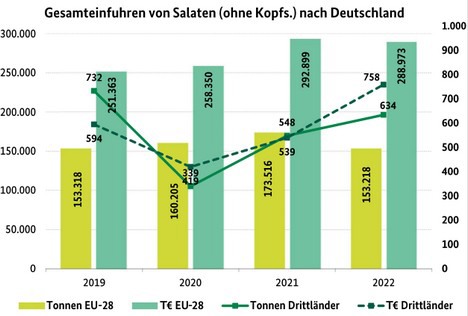The approaching end of the Central European lettuce season was clearly visible: On the one hand, deliveries from Germany, Belgium, and the Netherlands were reduced, and, on the other hand, their quality was no longer consistently convincing.
Quality was no longer consistently convincing. For lettuce and iceberg lettuce, a rather wide price range was therefore established in some cases. According to the BLE, this tendency was again clearly strengthened by the absence of some origins for days and by returns from food retail. Qualitatively convincing offers, sometimes also from protected cultivation, often became more expensive.

Spanish products increased their presence and, thanks to their low price, were also popular. Colorful salads came almost exclusively from within the country, and Belgian batches supplemented the shops. Marketing was steady, and prices fluctuated but ultimately showed a slight downward trend. In Hamburg, Frankfurt, and Munich, the first Italian endives could be accessed, and their campaign thus started.
Click here for the complete market and price report.
Apples
Local items prevailed and gained in importance once again. Elstar, Jonagold, Boskoop, Royal Gala, and Wellant formed the basis of the offer. The relevance of Braeburn and Topaz grew, and that of Pinova weakened. Italy participated primarily with Royal Gala and Granny Smith.
Pears
Santa Maria, Abate Fetel, and Williams Christ were the main pears from Italy. In Munich and Hamburg, the Italian deliveries became more expensive due to the purchase price. In Frankfurt, they did not generate the desired attention due to too high valuations, and in Berlin, their sales were rather leisurely.
Table grapes
Italian deliveries dominated, with Turkish Sultana the closest match in terms of volume. Valuations tended mostly upwards, triggered by increased provision of fruit in winter packs as well as by increased incoming demands.
Small-sized citrus fruits
Mandarins were still dominated by late South African varieties such as Nadorcott, Orri, and Tango. Spanish early varieties followed in terms of quantity. Peruvian imports and early Italian primasoles had a complementary, completing character. The clementines were exclusively Spanish, such as Oronules, Clemenrubi, or Marisol.
Lemons
Spanish offers gained in importance, but this had a negative impact on prices. South African imports, however, continued to dominate and mostly cost as much as the previous week.
Bananas
Supply and demand harmonized sufficiently. Traders, therefore, rarely had cause to modify their previous demands. Only in Frankfurt and Munich did the first brand become more expensive.
Cauliflower
Actually, domestic shipments predominated, only in Berlin there were mainly Dutch and Polish deliveries. The Italian deliveries increased immensely, the Belgian deliveries rounded off the assortment. The German season was entering the home stretch.
Cucumbers
With Spanish, Dutch, domestic, Belgian, and Greek deliveries, it was possible to access several origins. Greek deliveries, however, were only available in Munich. The quality was not entirely convincing; in some places, the Spanish, but also, in some cases, the domestic products, showed difficulties in terms of condition.
Tomatoes
The offer continued to be dominated by Dutch and Belgian fruits, whose importance, however, had decreased overall. Turkish panicles gained in relevance, and round tomatoes of this origin also played an increasingly important role. Italy mainly provided cherry tomatoes and Morocco round tomatoes.
Sweet peppers
Dutch, Spanish, and Turkish items formed the basis of the supply. The prices often showed an upward trend. Some of the price increases were very strong. The rising prices were triggered by a reduction in availability as well as by increased purchase requirements.
Source:BLE
